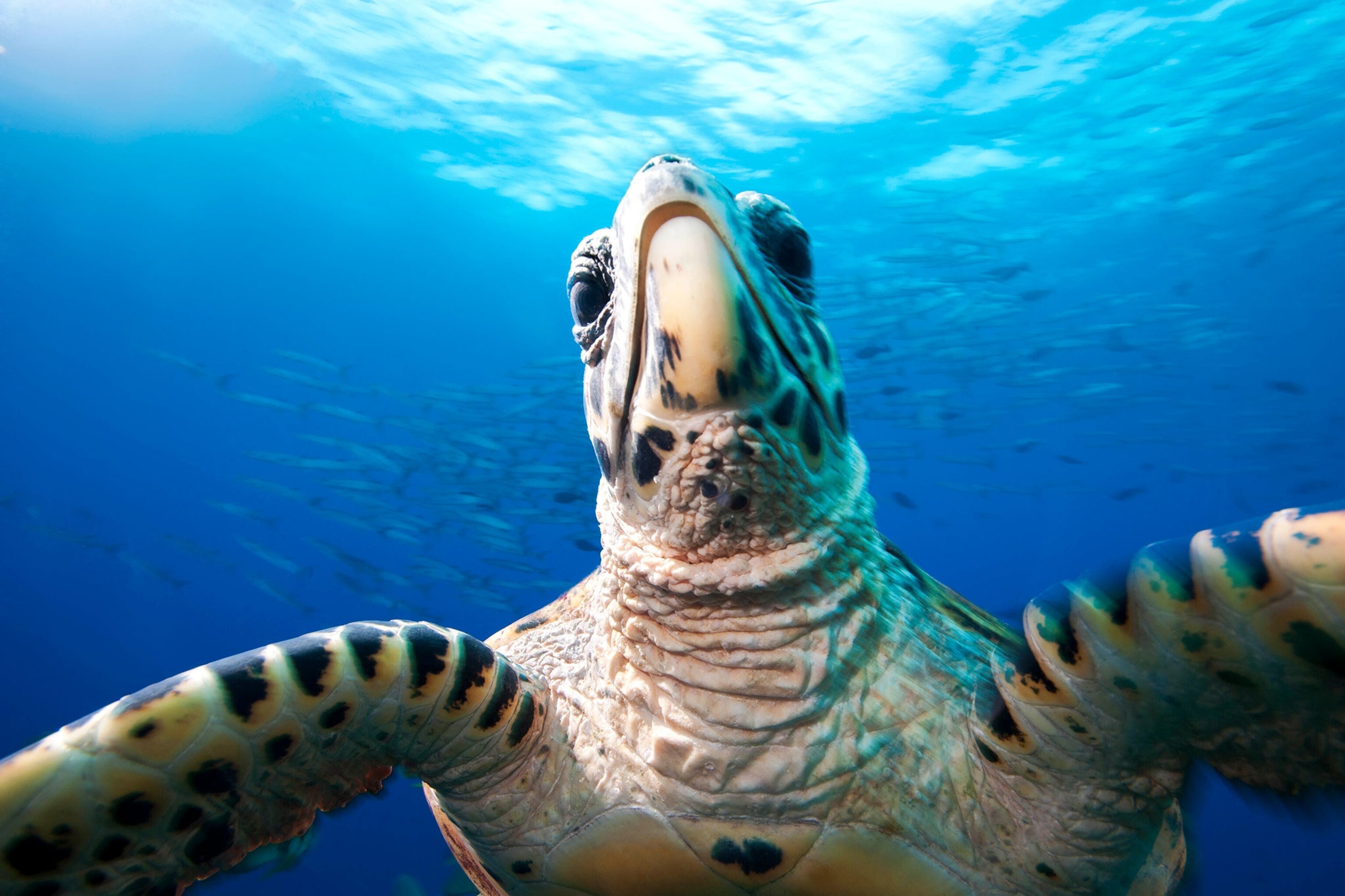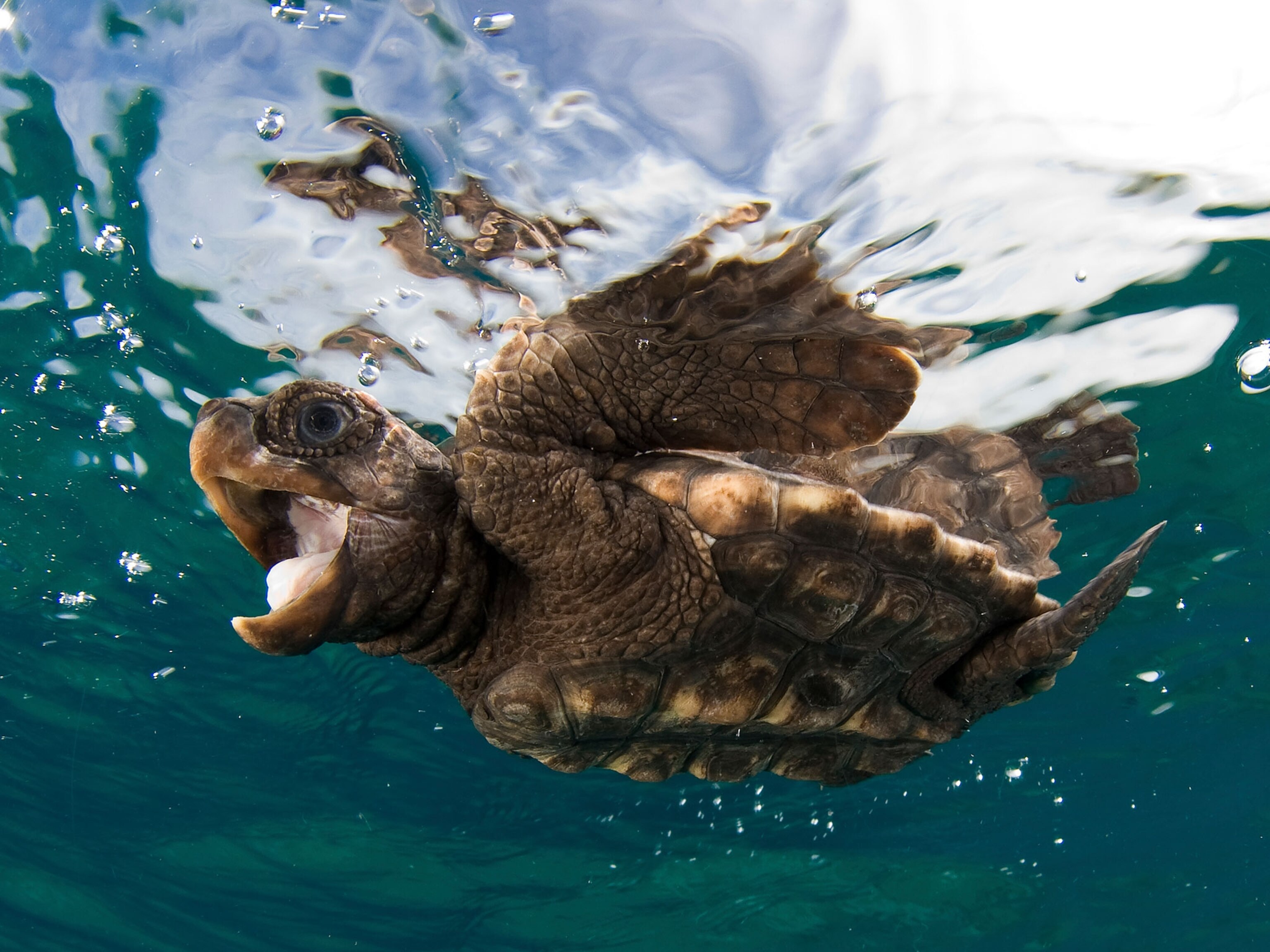


What If There Were No More Turtles?
A new study looks at the decline of a longevity icon.
One lovely thing about turtles is that they never look busy. They calmly browse the forest or sun themselves on a log, appearing to live a life of leisure.
Behind their chill demeanor, however, turtles are ecological movers and shakers, thanks to their digging, moving a lot farther than you’d think they do and moving between ecosystems, like the ocean and the beach.
They’re also widely beloved, the kind of animal you rarely hear of people having a problem with or fear of. They’re central to many mythologies and, as a first pet for many kids, they’re a gentle bridge between home and the wild.
They’re also a bit of a bridge between land and water, depending on the species.
“All animals with a backbone and a shell are turtles,” says Jeffrey Lovich, Research Ecologist at the U.S. Geological Survey, so it’s an umbrella term used for turtles, tortoises, and terrapins. “It’s the only animal that’s ever lived that has its hips and shoulder blades inside its rib cage.”
The distinction:Tortoises are land-only animals and do not swim. Turtles can be aquatic, semi-aquatic, or live mostly on land. Terrap)ins live in brackish water. (Related: How to Tell a Turtle From a Tortoise.)
So what would happen if they disappeared? (Related: Are Plastic Six-Pack Rings Still Ensnaring Wildlife?)
Turtles in Trouble
A number of turtle species are already at risk of vanishing. (Recent news: Police Raid What May Be Europe's Biggest Illegal Turtle Farm.)













The Yangtze giant softshell turtleis down to four individuals. The Northern River Terrapin, a species in which the males undergo dramatic color change in the breeding season, is being helped back from the brink of extinction by breeding programs such as the Turtle Survival Alliance in India and Turtle Island Conservation Breeding and Research Center for Turtles in Bangladesh. (Related: Turtle with a Green Mohawk Faces Extinction)
Between 2004 and 2014, desert tortoise populations in California, Nevada, and southern Utah declined 37 percent.
And those turtles are “protected under what may be the toughest environmental law in the world, the Endangered Species Act,” says Lovich, lead author of a new study in the journal Bioscience about the decline of turtles. A surprising 61 percent of the 356 turtles species have become extinct or threatened in the modern era.
It’s hard to imagine turtles in decline, but overexploitation for meat and the pet trade, climate change and habitat destruction are getting in the way of their impressive tenure on the Earth. (Related: Where are all the male sea turtles going?)
They outlasted the dinosaurs, but “no turtle has time to evolve to avoid being killed on a road,” says Whit Gibbons, emeritus professor of ecology at University of Georgia and co-author of the turtle study.
What They Do for Us
So what would a world without turtles look like?
First, let’s talk first about what it would smell like.
“Turtles are great scavengers, the garbage patrol of an area,” eating up dead fish from lakes and rivers, Gibbons says.
“They do no harm and they do a lot of good.”
Turtles also provide homes for a lot of critters. Burrows dug by gopher tortoises shelter over 350 species, including burrowing owls, rabbits, and bobcats.
Turtles are even bio-engineers, keeping the landscape healthy and varied by dispersing seeds. A box turtle that eats some strawberries and then walks half a mile and defecates the seeds is adding to the landscape. They also rotate including the sand on the sea floor, and redistributing energy from one ecosystem to another. Nesting sea turtles leave about 75 percent of their energy on land in the form of eggs and hatchlings before they return to sea.
A Poorer World
So, turtles do a lot for the world’s ecology. What else would we lose?
An absence of turtles would be a “cultural, psychological loss,” to many societies, Gibbons says. We revere their traits of persistence and serenity. They’re the one reptile that just about everyone likes.
“I’ve never heard anyone say “Gosh, I hope a turtle doesn’t get into my house,” he says.

















“They’re a paragon of survival, and it would be terrible if they’ve come through 200 million years and then in the last few centuries most are eliminated,” he says. “Not a very good legacy for us.”
One thing people can do, Lovich says, is not take wild turtles home. Get one at a rescue center where plenty of people relinquish those they no longer want as pets, a better plan than ‘setting them free,’ in the wild, where they don’t survive.
“Keep wild turtles wild,” Lovich says, and leave them where they are—for their sake and ours.
Finally, the world would just be less rich without these funny and unique animals. Gibbons likens it to losing another kind of happiness.
“If you took away all the Ferris wheels in amusement parks, you’d still have amusement parks,” he says. “But they’d be a little less exciting, wouldn’t they?”
Have a question about the weird and wild world? Tweet me or find me on Facebook . Weird Animal Question of the Week answers your questions every Friday.
You May Also Like
Go Further
Animals
- Octopuses have a lot of secrets. Can you guess 8 of them?
- Animals
- Feature
Octopuses have a lot of secrets. Can you guess 8 of them? - This biologist and her rescue dog help protect bears in the AndesThis biologist and her rescue dog help protect bears in the Andes
- An octopus invited this writer into her tank—and her secret worldAn octopus invited this writer into her tank—and her secret world
- Peace-loving bonobos are more aggressive than we thoughtPeace-loving bonobos are more aggressive than we thought
Environment
- This ancient society tried to stop El Niño—with child sacrificeThis ancient society tried to stop El Niño—with child sacrifice
- U.S. plans to clean its drinking water. What does that mean?U.S. plans to clean its drinking water. What does that mean?
- Food systems: supporting the triangle of food security, Video Story
- Paid Content
Food systems: supporting the triangle of food security - Will we ever solve the mystery of the Mima mounds?Will we ever solve the mystery of the Mima mounds?
- Are synthetic diamonds really better for the planet?Are synthetic diamonds really better for the planet?
- This year's cherry blossom peak bloom was a warning signThis year's cherry blossom peak bloom was a warning sign
History & Culture
- Strange clues in a Maya temple reveal a fiery political dramaStrange clues in a Maya temple reveal a fiery political drama
- How technology is revealing secrets in these ancient scrollsHow technology is revealing secrets in these ancient scrolls
- Pilgrimages aren’t just spiritual anymore. They’re a workout.Pilgrimages aren’t just spiritual anymore. They’re a workout.
- This ancient society tried to stop El Niño—with child sacrificeThis ancient society tried to stop El Niño—with child sacrifice
- This ancient cure was just revived in a lab. Does it work?This ancient cure was just revived in a lab. Does it work?
- See how ancient Indigenous artists left their markSee how ancient Indigenous artists left their mark
Science
- This 80-foot-long sea monster was the killer whale of its timeThis 80-foot-long sea monster was the killer whale of its time
- Every 80 years, this star appears in the sky—and it’s almost timeEvery 80 years, this star appears in the sky—and it’s almost time
- How do you create your own ‘Blue Zone’? Here are 6 tipsHow do you create your own ‘Blue Zone’? Here are 6 tips
- Why outdoor adventure is important for women as they ageWhy outdoor adventure is important for women as they age
Travel
- Slow-roasted meats and fluffy dumplings in the Czech capitalSlow-roasted meats and fluffy dumplings in the Czech capital
- Want to travel like a local? Sleep in a Mongolian yurt or an Amish farmhouseWant to travel like a local? Sleep in a Mongolian yurt or an Amish farmhouse
- Sharing culinary traditions in the orchard-filled highlands of JordanSharing culinary traditions in the orchard-filled highlands of Jordan







